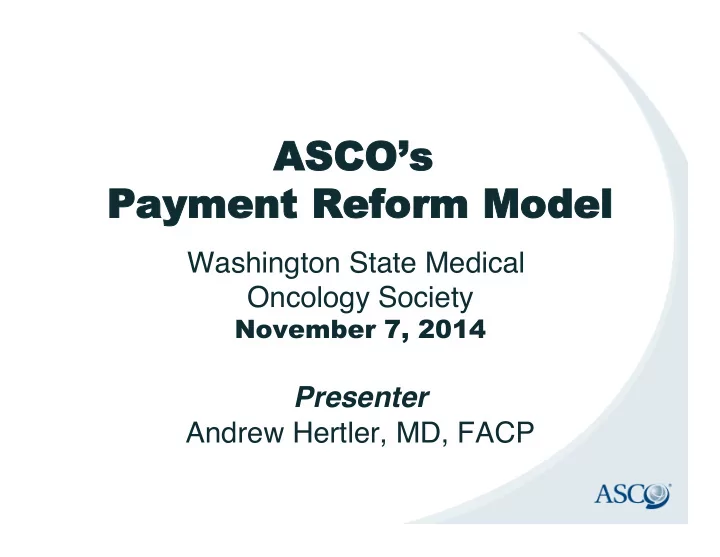

ASCO’ O’s Pay ayment ment Ref efor orm m Model odel Washington State Medical Oncology Society November 7, 2014 Presenter Andrew Hertler, MD, FACP
Conflict of Interest Information • Dr. Hertler is employed by and has stock options in New Century Health.
Consolidated Payments for Oncology Care Payment Reform to Support Patient-Centered Care for Cancer ASCO’s ¡Clinical ¡Prac/ce ¡Commi3ee ¡ Payment ¡Reform ¡Work ¡Group ¡ ¡ ¡ ( JOP Jul 1, 2014:254-258; published online on April 15, 2014 ) ¡
Rough Waters for Practices § Economic pressures § Political turbulence § General disruption across medicine § Sequestration § ICD-10 § PQRS, Meaningful Use § Health Reform § ACOs, shifts in practice environment § Performance based payment § Wave of newly insured § Uncertainty
How Are Payers Responding? § Focus on cost and value § Proliferation of pathway/quality reporting programs § Push for efficiencies (e.g., EHR) § Exploring new payment models (e.g., bundling)
Including Policymakers… SGR Repeal Bill § Repeals SGR § Encourages testing of specialty specific payment models § Credit for participation in QCDRs CMS § Payment Reform Model Released § Eager to hear from specialties about different models
Goals of CPOC § Payment structure § Patient centered § Better match to services we provide/patients need § Simpler billing structure § More predictable revenue stream § Incentivize high quality, high-value care § Support coordinated, patient-centered care
Monthly Payments Based on Phases of Care New Patient Treatment Month Monitoring Month Transition of Treatment
• Single payment New • Includes patient evaluation, treatment Patient planning, patient education Payment • Diagnostic testing paid separately
• Single payment each month patient receives treatment (IV or oral therapy) Treatment • May receive both a treatment month Month payment and a new patient payment in the same month Payment • Higher monthly payments for sicker patients and those receiving more toxic and complex regimens
• For patients not receiving active anti-cancer therapy (e.g. treatment holiday or completion) Monitoring Month • 3 levels of payment • Higher for months immediately Payment following end of treatment • Lower for patients on long-term monitoring
• Patient beginning new line of therapy or ending Transition treatment with no further treatment planned of Treatment • Reflects time involved in Payment treatment planning and patient education
Current vs. Proposed Payments C URRENT P ROPOSED § E&M (new patient) § New patient § E&M (established payment patient) § Treatment month § Consultations payment § Chemotherapy § Transition of administration/ treatment payment therapeutic injections/ § Active monitoring hydration month payment
Continued FFS Payments § Laboratory tests § Bone marrow biopsies § Portable pumps § Blood transfusions § (list not all inclusive)
Multi-Year Transition Design § Net revenue to practice > existing system § Total spending by payer < existing system § Payer and practice negotiate acceptable risk corridors during transition Practices protected against losses in initial years § Payers and practices share in savings achieved § Practices take on greater accountability as care § processes redesigned
Additional Payment Adjustments § Quality measures phased in over time § Pathways, two stages: § Adherence § Use of certified pathways § Resource utilization § OMH § ER and hospital admissions § Clinical Trials § Higher Treatment Month and Non-Treatment Month payments for enrolled patients
Reimbursement by Category: Today vs. Tomorrow
Example: Stage III Colon Cancer, FOLFOX VI, 12 Cycles
Expected Impacts § More flexibility for practices § Practices accountable for quality of care and costs § Simplification: replaces 58 codes with 11 codes
CMMI vs. CPOC: Some Observations CMMI: OCM ASCO: CPOC § Fee for service—current narrow § Flexible payments can reimburse categories currently unfunded services § Reimbursement still driven by § Patient centered reimbursement, physician encounter agnostic to type of provider § Add on payment only for new § Monthly payment replaces current services fees § Accountability for ALL § Focuses accountability on services healthcare services controlled by oncologists § Arbitrary 6-month episodes § Monthly payment based on phase of treatment and care § Payment differentiated only by § Payment differentiated by patient type of cancer complexity and treatment toxicity
DISCUS USSION ON
Recommend
More recommend